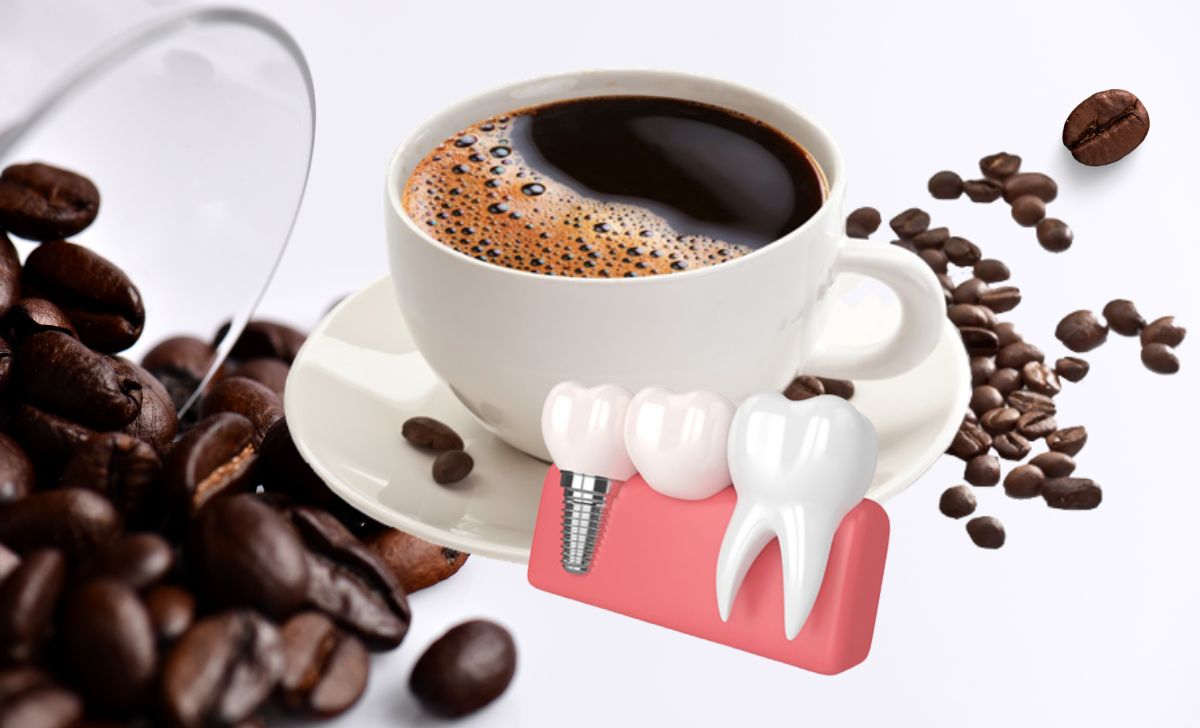For coffee lovers, the question “can I drink coffee after gum graft surgery?” may often cross their minds. But the answer is not as simple as yes or no. A gum graft surgery is a delicate oral procedure that helps restore gum health and aesthetics. It may be necessary in cases of advanced periodontal disease, severe gum recession, or for the preparation of new dental implants. The healing process post-surgery is crucial, and what you consume, including your favorite drink, can greatly impact it. This article offers insights into the do’s and don’ts after a gum graft surgery, focusing on your consumption of coffee, the role it plays in your recovery, and alternative food and drink options for a smooth recovery.
Gum Graft Surgery Overview
A gum graft surgery is a common yet important procedure aimed at restoring your gum line and improving oral health. This surgical procedure involves taking soft tissues or a collagen matrix, like Geistlich Mucograft or Geistlich Fibro-Gide, from one part of the mouth, often the roof of your mouth, and grafting it onto the affected area. The goal is to cover exposed tooth roots, combat gum recession, and prevent further dental complications. Dentists or oral surgeons perform this surgery, and specific instructions are given to patients for post-surgery care to ensure a quick and effective recovery. These instructions often include a recommended diet, oral hygiene practices, and activities to avoid.
Can I Drink Coffee After Surgery?
The initial period following your gum graft surgery is vital for the healing process. Many patients wonder, “can I drink coffee after gum graft surgery?” While coffee may be your preferred way to start the day or a favorite afternoon pick-me-up, it may not be the best choice immediately after your surgery.
Hot coffee, along with other hot drinks and foods, can interfere with the formation of a blood clot at the surgical site. This blood clot is paramount to the healing process and protecting the surgical area. Furthermore, the caffeine in coffee can have a diuretic effect, potentially leading to dehydration, which can slow down the recovery process.
It’s advised to avoid hot beverages like coffee, hot chocolate, and even hot foods for at least the first day after surgery, or until your dentist gives you the go-ahead. However, this doesn’t mean you have to forego your caffeine fix entirely. Options like iced coffee or cold brew can be a safe and enjoyable alternative, provided they are consumed carefully and without a straw, as the suction could disrupt the surgical site.
Healing Process and Recovery
The healing process after gum graft surgery typically involves a few weeks, but the most critical period is the first week. During this time, it’s important to follow your dentist’s instructions closely. This includes taking any prescribed antibiotic or pain medication, maintaining good oral hygiene, and following a soft food diet.
For the first day, cold liquids are your safest bet to avoid disrupting the surgical site. Room temperature or cold water, fruit juice, and high protein liquid diet supplements are good choices. As you move into the second and third day, soft foods like cottage cheese, ice cream, and soft vegetables can be introduced. Avoid hot, hard, or crunchy foods that could potentially damage the surgical area or disturb the healing process.
Avoid strenuous exercise in the first few days to ensure you don’t raise your blood pressure and disrupt the surgical site. In terms of oral hygiene, brushing the teeth adjacent to the surgical site should be done with caution. Electric toothbrushes should be avoided initially as they may cause unwanted pressure on the gum tissue. Your oral surgeon will provide you with specific guidelines tailored to your specific situation.
Remember, the speed of your recovery and the effectiveness of the surgery outcome greatly depends on how well you follow post-surgery instructions and care for your oral health.
Effects of Hot and Cold Temperatures
The temperature of the food and beverages you consume plays a critical role in the recovery process after a gum graft surgery. As mentioned earlier, hot drinks and foods, like hot coffee or soup, can disrupt the blood clot at the surgical site, potentially leading to complications such as a dry socket. Hence, it’s essential to steer clear of hot foods and drinks for the amount of time recommended by your dentist or oral surgeon.
On the other hand, cold foods and cold liquids can be soothing and beneficial. The cold temperature can help reduce inflammation and soothe the surgical area. Ice packs applied to the outside of your face can also provide relief. Furthermore, it’s important to keep your body hydrated during the recovery period. However, it’s crucial to consume cold beverages without a straw, as the suction could disrupt the healing process. Foods like ice cream, smoothies, and cold soups can also help maintain your nutrition while promoting a smooth recovery.
Importance of a Soft Food Diet
Following a soft food diet after a gum graft surgery is crucial to ensure a speedy recovery. The soft texture of these foods protects the surgical site, aiding the healing process without causing further irritation or damage. For the first week post-surgery, stick to a diet of soft foods and cold liquids to allow the gum tissue to heal properly.
Foods like cottage cheese, soft bread, sweet potatoes, and other soft vegetables are easy to chew and swallow, minimizing the pressure on the surgical area. Ice cream and cold soups are also good choices. A high protein liquid diet supplement can help maintain your nutritional needs during the recovery period.
It’s worth noting that although hot coffee and other hot beverages are not recommended immediately after the procedure, cold coffee or cold brew can be consumed carefully. However, always remember to avoid drinking with a straw as the suction can disturb the surgical site.
A soft food diet, along with proper oral hygiene and following your dentist’s instructions, is the key to a quick recovery and successful surgical outcome.
Oral Hygiene and Care Instructions
Maintaining good oral hygiene after gum graft surgery is paramount to prevent infection and promote healing. However, usual brushing and flossing routines will need to be modified to protect the surgical site.
In the first week following the procedure, avoid brushing the surgical area. Instead, you may be instructed to rinse your mouth with warm water and salt or a special mouth rinse. An electric toothbrush should be avoided during this time as it could cause unwanted pressure on the healing gums.
Flossing should also be done with care, avoiding the surgical area until it has healed sufficiently. Your dentist will provide you with specific instructions about when you can resume your regular oral hygiene routine.
Smoking and consumption of alcoholic beverages should be avoided, as both can interfere with the healing process. Not only can they disrupt the blood clot crucial for healing, but they can also lead to dry socket and other complications.
Following your oral surgeon’s instructions closely, maintaining good oral hygiene, and being aware of what you eat and drink can lead to a successful recovery with the best possible results.
Post-Operative Pain Management
While gum graft surgery is a simple dental procedure, some discomfort and pain are normal in the first few days following surgery. The good news is that pain can be effectively managed with over-the-counter pain medication or prescriptions from your dentist or oral surgeon. It’s important to take the medication as instructed to keep discomfort at a minimum.
Cold packs applied to the face can also help to reduce swelling and soothe the surgical site. Furthermore, eating cold foods and drinking cold liquids, like ice cream and cold water, can provide relief to the surgical area.
In the event of severe pain that isn’t eased with prescribed medication, it’s important to contact your dental health professional for advice. Every patient’s recovery process is unique, and sometimes adjustments to pain management strategies may be needed. Always remember to follow your dental health professional’s specific instructions for a successful recovery with the least amount of discomfort.
Potential Complications
As with any surgical procedure, gum graft surgery comes with potential risks and complications. These are rare and can be minimized by following your dental health professional’s instructions and maintaining good oral hygiene. However, it’s essential to be aware of these complications so you can act promptly if you notice any signs.
Dry socket is one such complication where the blood clot at the surgical site gets dislodged or dissolves before the wound has healed. This can cause severe pain and delay the healing process. Drinking hot beverages like coffee, vigorous rinsing, and the use of straws can contribute to the occurrence of a dry socket.
Infection is another potential complication, though it’s less common thanks to the use of antibiotics post-surgery. Signs of infection include severe pain, prolonged bleeding, unusual swelling, and fever. If you notice any of these signs, it’s important to contact your dental health professional immediately.
Remember, the key to a successful recovery and effective outcome lies in following your dental health professional’s instructions, maintaining good oral hygiene, and keeping a careful eye on the recovery process.
Alternatives to Hot Coffee
If you’re a coffee lover facing gum graft surgery, don’t despair. While hot coffee should be avoided in the initial recovery period, there are numerous tasty alternatives that you can enjoy while still maintaining the healing process. Here are a few:
Cold Brew
Prepared by steeping coffee grounds in cold water for an extended period, cold brew coffee is a wonderful alternative to hot coffee. It’s served cold and offers a smoother, less acidic flavor that’s perfect for soothing your mouth post-surgery. Remember to drink it without a straw to protect the surgical site.
Iced Coffee
Made by brewing hot coffee and then cooling it in the refrigerator, iced coffee is another great option. You can enjoy it black, or add some milk for a creamier texture. Avoid using a straw, and enjoy the refreshing taste while still getting your caffeine fix.
Room Temperature Coffee
If you’re not a fan of cold coffee, room temperature coffee can also be a safe alternative. Brew your coffee as usual, then allow it to cool to room temperature before drinking. This allows you to enjoy the robust flavors of coffee without the risk of disrupting the surgical site.
Remember, while these alternatives allow you to enjoy your favorite drink, it’s crucial to consume them carefully, protecting the surgical site, and promoting a speedy recovery.
Related Posts:
- Can I Drink Iced Coffee After Tooth Extraction? Yes or No?
- Best Nitro Cold Brew Coffee
- Does Cold Brew Coffee Go Bad? Fridge vs Room Temp

